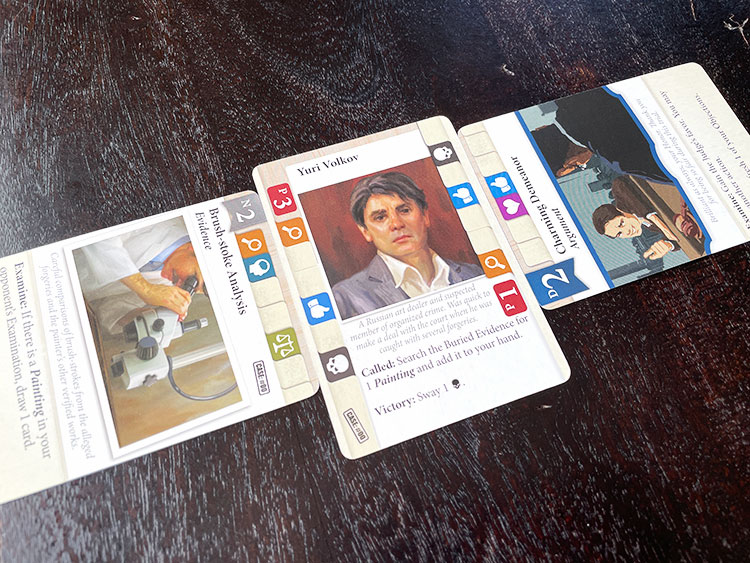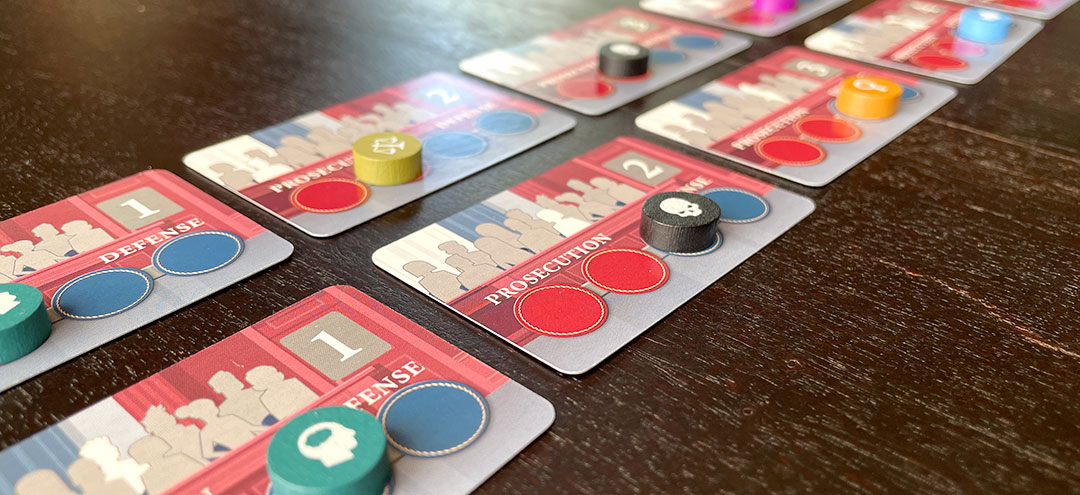 In the 1957 classic film 12 Angry Men, Juror #8 gave us key insight into the weight and time necessary to reach a verdict: “We’re talking about somebody’s life here. We can’t decide it in five minutes.” And he was right. Five minutes is certainly not enough time. In Lawyer Up, it takes approximately sixty to ninety minutes to close the case.
In the 1957 classic film 12 Angry Men, Juror #8 gave us key insight into the weight and time necessary to reach a verdict: “We’re talking about somebody’s life here. We can’t decide it in five minutes.” And he was right. Five minutes is certainly not enough time. In Lawyer Up, it takes approximately sixty to ninety minutes to close the case.
Published by Rock Manor Games and designed by Samuel W. Bailey and Mike Gnade, this two-player courtroom card game pits Prosecution against Defense in two distinct and variable cases.
Have you prepared all your legal documents? Is your opening statement convincing? Then it’s time to step into the courtroom and see if you can handle the truth.
Gameplay Overview:
The two cases featured in the base game of Lawyer Up are Case 00: Art of the Crime and Case 01: Fairmont Tragedy. Both cases include special victory conditions and several starting setups to add variety over multiple plays. A judge presides to shift favor between the prosecution and the defense. Twelve jurors begin with randomized bias tokens that need to be swayed via influence throughout play.
Prosecution and Defense both have a starting deck of twenty-six cards, three objection tokens, and a sidebar token. Prior to play, players enter the Discovery phase and draft for case-specific cards. Each player chooses one to keep, one to pass to the opposition, and one to add to the buried evidence stack. The drafted cards are shuffled together with the starting deck to create their case deck. Prosecution and Defense each draw five cards to begin.

The setup instructions for each case specify the counsel witnesses available. The prosecution starts with the judge’s favor and calls the first witness, which begins a Questioning phase. During this phase, players alternate turns playing evidence or argument cards, playing or activating procedure cards, requesting a sidebar, or passing. Objections can be used during the opposing player’s turn to overturn a powerful argument card, but there are only three objections for the entire case, so they must be used wisely.
Each evidence, argument, or procedure card features several icons that represent different biases. The icons also appear on the randomly seeded juror tokens and play an important role in swaying bias to compete for a win. When playing a card during Questioning, players must match icons to the witness or card recently played. If unable to match an icon, the player may need to use a sidebar action to draw a card or pass if unable to muster enough influence.
Once both players have passed, they resolve the witness by comparing influence gained on cards that match player colors (red for Prosecution, blue for Defense), resolve victory or defeat effects present on specific cards, and then the winner spends the amount of influence they’ve gained over the opposition to sway the jury. Two rows of jurors are numbered one to six, and these values represent the amount of influence that must be spent to shift bias in either direction. In Case 00, the winner is the counsel who has the most jurors swayed to their side, whereas in Case 01, the prosecution only wins if they’ve swayed all jurors to their side.

Game Experience:
The drama of a courtroom battle comes alive in a game of Lawyer Up. Game mechanics incorporate into the theme and there’s plenty of great card powers to ramp up the argumentative pressure. Whether you’re trying to make a piece of evidence inadmissible (by removing a card), calling a recess (to enhance your arguments going forward), or addressing the jury (to sway a bias), most card actions feel integral to the legal dance.
The Discovery phase, while creating a lot of upfront analysis, represents the two counsels weighing the evidence of the case and deciding which to use. The fact that during the draft players can pass cards to their opponent’s hand and discard cards from the case gives weight to the decision space and adds to the replayability. Players can also choose to randomize the case-specific deck to minimize decision making.

Calling a witness and attempting to influence the jury with your arguments is a blast. Not only are you attempting to chain icons on your cards to present a coherent presentation, but you’re also watching your opponent’s cards to see when you can object or take advantage of a weak point in their evidence. Every new witness phase starts with each player drawing up to five cards, so each Questioning is itself a small minigame of trying to build the best attack, as well as knowing when to pass for better opportunities later.
Having the judge’s favor is also an integral part of each Questioning round. Favor allows players to activate a procedure card, whereas the favor can be regained by asking for a sidebar and drawing a new card. Knowing when to take advantage of favor can be hard and it only takes a moment for your opponent to claim it and waylay a key strategy.
When elements come together in Lawyer Up, it’s a satisfying feeling. The artwork only enhances the theme cohesion, adding a bit of humor, mystery, and astonishment to the mix. One of my favorite pieces of art is featured on the card Surprise Witness, showcasing a new witness busting in through the door in the back of the courtroom. Lawyer Up’s visual style also does an excellent job of integrating representation with a diverse cast of characters of all ages.

That said, there are times when you’re stuck with a hand of cards with icons that don’t match up well, or perhaps don’t even provide enough influence to claim the witness. These moments pull away from the thematic narrative central to engagement, and make it difficult to find a work around. During my plays, I typically took these moments as lapses in judgment, lack of preparation, or inadequate connection to the witness. And while they can be frustrating, there’s typically enough time in each case to scramble back from the brink.
Another small issue I found was present in both the rulebook and some of the card text. There are a few small misprints littered throughout, including a couple of cards labeled incorrectly (easy to notice and play around). But the larger issue for us was a rule that wasn’t properly clarified in the rulebook regarding primary and secondary values on the witness cards (and their corresponding colors), which left us digging through the BGG forums for official word.

The fact that Lawyer Up comes with two cases and multiple setups for each of these provide plenty of value. Add to this the fact that players can switch which side they represent, change the length of the game by adding or removing cards (in Case 00), or changing an opening strategy (in Case 01), there’s plenty to discover. Beyond the introduction judge, the game also features judges with distinct biases that change interactivity.
Note: There is a solo option for Lawyer Up, which felt half-baked without much development. It’s also only available for Case 00 which limits the appeal.
Final Thoughts:
Lawyer Up is a unique entry to the two-player card battler that oozes with theme. The mechanical integration is excellent for the most part. There’s area influence, card drafting, pattern building, and set collection at play. What’s more, the framework for each round provides an interesting puzzle to solve for each witness being questioned. Add to that needing to keep an eye on the judge, the stockpile of procedures at the ready for your opposition, and the constant shifting of the jury bias, and there’s a lot of intricacies to navigate. Lawyer Up is a game that refutes the old joke about lawyers at the bottom of the sea and makes the legal system something that’s worth building a case around. And as the judge says in 12 Angry Men, “It’s now your duty to sit down and try and separate the facts from the fancy.”
Final Score: 4 Stars – An engaging legal battle filled with diverse characters, tough decisions, and tense objections. And maybe a little evidence tampering, too.
 Hits:
Hits:
• Card chains create thematic depth
• Jury bias and judge manipulation
• Discovery phase drafting
• Diverse card artwork
Misses:
• Potential luck of draw issues
• Rule confusion and misprints






















